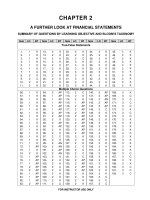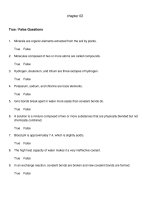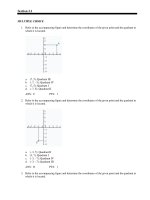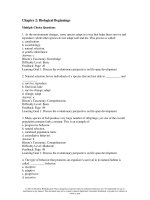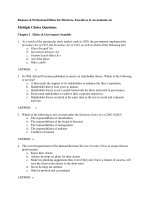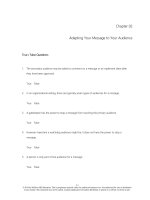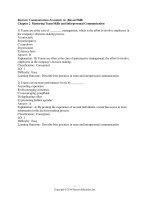The world economy geography business development 6th edition stutz test bank
Bạn đang xem bản rút gọn của tài liệu. Xem và tải ngay bản đầy đủ của tài liệu tại đây (145.99 KB, 50 trang )
The World Economy: Geography, Business, Development, 6e (Stutz/Warf)
Chapter 2 The Historical Development of Capitalism
2.1 Multiple Choice
1) What is the dominant form of production and consumption around the world?
A) Capitalism
B) Command
C) Fordism
D) Laissez-faire
E) Mercantilism
Answer: A
Diff: 1
Topic/Section: Historical Development of Capitalism
Standard: 3: How to analyze the spatial organization of people, places, and environments on
Earth's surface.
Bloom's: Knowledge
2) On what is the capitalist class system based?
A) religious rank
B) tradition, family status
C) military rank
D) money and earned status
E) education
Answer: D
Diff: 2
Topic/Section: The Rise of the Modern City
Standard: 10: The characteristics, distribution, and complexity of Earth's cultural mosaics.
Bloom's: Knowledge
3) Where did capitalism begin?
A) The Middle East
B) China
C) India
D) United States
E) Northern Italy
Answer: E
Diff: 2
Topic/Section: Environment
Standard: 11: The patterns and networks of economic interdependence on Earth's surface.
Bloom's: Knowledge
1
Copyright © 2012 Pearson Education, Inc.
4) How would one describe markets under feudalism?
A) small and poorly developed
B) middle-sized and unevenly developed
C) large and well-developed
D) a mix of small and middle-sized markets, most of which were well developed
E) non-existent
Answer: A
Diff: 3
Topic/Section: Feudalism and the Birth of Capitalism
Standard: 11: The patterns and networks of economic interdependence on Earth's surface.
Bloom's: Knowledge
5) When did modern capitalism come into existence?
A) first and second centuries
B) fifth and sixth centuries
C) ninth and tenth centuries
D) twelfth and thirteenth centuries
E) sixteenth and seventeenth centuries
Answer: E
Diff: 2
Topic/Section: Emergence and Nature of Capitalism
Standard: 17: How to apply geography to interpret the past.
Bloom's: Analysis
6) Originally, where did modern capitalism mostly come into being?
A) Central Asia
B) Eastern South America
C) Pacific Rim
D) Southern Africa
E) Western Europe
Answer: E
Diff: 1
Topic/Section: Emergence and Nature of Capitalism
Standard: 17: How to apply geography to interpret the past.
Bloom's: Analysis
7) When did the Industrial Revolution begin?
A) twelfth century
B) fourteenth century
C) seventeenth century
D) eighteenth century
E) twentieth century
Answer: A
Diff: 1
Topic/Section: Industrial Revolution
Standard: 17: How to apply geography to interpret the past.
Bloom's: Analysis
2
Copyright © 2012 Pearson Education, Inc.
8) Many early agricultural societies were based on
A) climate.
B) dependencies.
C) mechanical advancements.
D) slavery.
E) technology.
Answer: D
Diff: 2
Topic/Section: Feudalism and the Birth of Capitalism
Standard: 17: How to apply geography to interpret the past.
Bloom's: Analysis
9) Prior to capitalism, the prevailing form of economic and social relations was
A) command economies.
B) feudalism.
C) mercantilism.
D) stock exchanges.
E) warehousing.
Answer: B
Diff: 1
Topic/Section: Feudalism and the Birth of Capitalism
Standard: 17: How to apply geography to interpret the past.
Bloom's: Analysis
10) Which area of the world was the least impacted by feudalism?
A) Europe
B) Holy Roman Empire
C) Japan
D) North America
E) Russia
Answer: D
Diff: 3
Topic/Section: Feudalism and the Birth of Capitalism
Standard: 17: How to apply geography to interpret the past.
Bloom's: Analysis
11) Which is a characteristic of feudalism?
A) a stable and conservative world that changed relatively little
B) dominance from a military class that represented the interests of the masses
C) large cities that had different sectors based on specific economic roles
D) ports that were linked to one another through an advanced system of bookkeeping
E) world trade
Answer: A
Diff: 1
Topic/Section: Characteristics of Feudalism
Standard: 17: How to apply geography to interpret the past.
Bloom's: Analysis
3
Copyright © 2012 Pearson Education, Inc.
12) What was the predominant political/ideological institution in Europe during feudalism?
A) the Church
B) the English Monarchy
C) the Roman Empire
D) the stock market
E) There was none.
Answer: A
Diff: 2
Topic/Section: Characteristics of Feudalism
Standard: 17: How to apply geography to interpret the past.
Bloom's: Analysis
13) What was NOT a feature of feudalism in Europe?
A) Most people were extremely religious.
B) The population fatalistically accepted its lot in life.
C) In most towns the Cathedral was the largest and most impressive building.
D) Most people were literate so they could read the Bible.
E) An aristocratic nobility made up the ruling class.
Answer: D
Diff: 3
Topic/Section: Characteristics of Feudalism
Standard: 17: How to apply geography to interpret the past.
Bloom's: Analysis
14) What was NOT a feature of feudalism in Europe?
A) There was an effective division between public and private property.
B) Tenant farmers paid tribute to their local lords with their agricultural output.
C) Farming was based on animate sources of power.
D) Agricultural productivity was low.
E) Children often labored on farms.
Answer: A
Diff: 3
Topic/Section: Characteristics of Feudalism
Standard: 17: How to apply geography to interpret the past.
Bloom's: Analysis
15) Under feudalism, what was the central institution that governed allocation of resources?
A) the Church
B) the cities
C) the market
D) the serfs
E) the state
Answer: E
Diff: 3
Topic/Section: Characteristics of Feudalism
Standard: 17: How to apply geography to interpret the past.
Bloom's: Analysis
4
Copyright © 2012 Pearson Education, Inc.
16) What was the basis of wealth and political power under the feudal system?
A) ownership of land
B) military technology
C) proximity to Rome (and thus access to the Pope)
D) ties to other empires
E) world trade
Answer: A
Diff: 2
Topic/Section: Characteristics of Feudalism
Standard: 17: How to apply geography to interpret the past.
Bloom's: Analysis
17) In the feudal era, which group of people were often merchants during seasonal fairs?
A) Jews
B) Norse
C) Roma (also known as Ruthenians or Gypsies)
D) Vandals
E) Visigoths
Answer: A
Diff: 2
Topic/Section: Characteristics of Feudalism
Standard: 17: How to apply geography to interpret the past.
Bloom's: Analysis
18) What is NOT a characteristic of serfs in Europe?
A) low standard of living
B) low life expectancies
C) monotonous lives
D) ownership by a master
E) they made up most of the rural population
Answer: D
Diff: 3
Topic/Section: Characteristics of Feudalism
Standard: 17: How to apply geography to interpret the past.
Bloom's: Analysis
5
Copyright © 2012 Pearson Education, Inc.
19) What was NOT a characteristic of cities during the era of feudal society?
A) Cities over 10,000 people were rare.
B) Commercial and residential districts were separated.
C) They were densely populated.
D) They were unsanitary.
E) They were often surrounded by walls.
Answer: B
Diff: 2
Topic/Section: Characteristics of Feudalism
Standard: 3: How to analyze the spatial organization of people, places, and environments on
Earth's surface.
Bloom's: Analysis
20) What were feudal guilds?
A) royal city planners
B) travelling merchants
C) associations of craft artisans and workers
D) religious orders of the Catholic Church
E) ruling classes who oversaw serfs
Answer: C
Diff: 1
Topic/Section: Characteristics of Feudalism
Standard: 17: How to apply geography to interpret the past.
Bloom's: Analysis
21) In the late medieval period, various technologies like the heavy plow and waterwheels were
introduced in Europe. Where did these innovations come from?
A) Arabs, Indians, and Chinese
B) Carpathian Mountains
C) Florence, Rome, and Venice
D) Jews
E) North Africans
Answer: A
Diff: 3
Topic/Section: The End of Feudalism
Standard: 9: The characteristics, distribution, and migration of human populations on Earth's
surface.
Bloom's: Knowledge
6
Copyright © 2012 Pearson Education, Inc.
22) What was the name for the series of routes that linked Asia and Europe for 2000 years of
trade?
A) Byzantium Terminus
B) Himalayan Highway
C) Khyber Pass
D) Long Trek Eastward
E) Silk Road
Answer: E
Diff: 2
Topic/Section: The End of Feudalism
Standard: 17: How to apply geography to interpret the past.
Bloom's: Analysis
23) Which is NOT TRUE regarding the Silk Road?
A) It passed through the Arab World.
B) The Chinese established customs posts to minimize smuggling and tax goods.
C) Religious ideas also passed along this route.
D) The flow of goods was essentially one-way, from Asia to Europe.
E) It lasted for around 2000 years.
Answer: D
Diff: 2
Topic/Section: The End of Feudalism
Standard: 17: How to apply geography to interpret the past.
Bloom's: Analysis
24) What disease wiped out one-quarter of Europe's population around 1350?
A) bubonic plague
B) influenza
C) malaria
D) measles
E) smallpox
Answer: A
Diff: 1
Topic/Section: The End of Feudalism
Standard: 17: How to apply geography to interpret the past.
Bloom's: Analysis
7
Copyright © 2012 Pearson Education, Inc.
25) Where did the bubonic plague originate?
A) Asia
B) Australia
C) North America
D) South America
E) southern Africa
Answer: A
Diff: 3
Topic/Section: The End of Feudalism
Standard: 17: How to apply geography to interpret the past.
Bloom's: Analysis
26) Several historians speculate that the bubonic plague caused Europe to change from
A) an unsanitary society to a sanitary society, especially in central Europe.
B) a credit-rich economy to a cash-poor economy.
C) being a rural region to an urbanized region.
D) being an urbanized region to a rural region.
E) a land-poor, people-rich to a people-poor, land-rich group of societies.
Answer: E
Diff: 3
Topic/Section: The End of Feudalism
Standard: 12: The processes, patterns, and functions of human settlement.
Bloom's: Synthesis
27) What economic, political, and social system emerged from the collapse of feudalism?
A) representative government
B) autocracy
C) democracy
D) world trade
E) capitalism
Answer: E
Diff: 1
Topic/Section: The End of Feudalism
Standard: 17: How to apply geography to interpret the past.
Bloom's: Analysis
28) What is the birthplace of capitalism?
A) Constantinople (Istanbul)
B) Greece
C) Iberia
D) northern Italy
E) western Ireland
Answer: D
Diff: 1
Topic/Section: The End of Feudalism
Standard: 17: How to apply geography to interpret the past.
Bloom's: Knowledge
8
Copyright © 2012 Pearson Education, Inc.
29) What was network of cities in northern Europe along the shores of the North Sea and Baltic
Sea?
A) Bal-Nor Group
B) Gronkowski Alliance
C) Hanseatic League
D) Odin's Realm
E) Waterford
Answer: C
Diff: 1
Topic/Section: Emergence of Capitalism
Standard: 11: The patterns and networks of economic interdependence on Earth's surface.
Bloom's: Knowledge
30) What was the core area of the Hanseatic League?
A) highlands of the British Isles
B) lowlands of central France (today the region of greater Paris)
C) shores of the Baltic Sea and North Sea (modern Germany and Poland)
D) mountains of Eastern Europe (Hungary and Romania)
E) coastline of the Mediterranean Sea, particularly Algeria and Spain
Answer: C
Diff: 2
Topic/Section: Emergence of Capitalism
Standard: 17: How to apply geography to interpret the past.
Bloom's: Knowledge
31) Under capitalism, what is the most important institution of allocation of resources?
A) the autocrats
B) the elites
C) the government
D) the market
E) the state
Answer: D
Diff: 1
Topic/Section: Markets
Standard: 11: The patterns and networks of economic interdependence on Earth's surface.
Bloom's: Synthesis
9
Copyright © 2012 Pearson Education, Inc.
32) What was a feature of the area where capitalism was born?
A) It was made up of a variety of city-states.
B) People there had no experience with money until 1800.
C) The people were heavily taxed in order to build flood walls, which led to the creation of
central banks.
D) It was governed by an absolute dictator.
E) It had religious diversity (Catholics, Hindus, Muslims, Protestants).
Answer: A
Diff: 1
Topic/Section: Markets
Standard: 17: How to apply geography to interpret the past.
Bloom's: Knowledge
33) In capitalism, what are oligopolists?
A) bankers who establish lines of credit
B) major producers who can shape the market price for their goods
C) traders who often manipulate the supply of goods in order to maximize profits
D) merchants who choose to sell as much as possible at low prices
E) forts and supply stations along trade routes
Answer: B
Diff: 3
Topic/Section: Markets
Standard: 11: The patterns and networks of economic interdependence on Earth's surface.
Bloom's: Synthesis
34) Which of the following is TRUE regarding capitalism?
A) City-states are required stepping stones for development.
B) All early capitalist societies practiced slavery.
C) Stock markets must exist to raise money.
D) In producer-based economies, governments must organize and muster resources to serve the
interests of the wealthy classes.
E) In market-based societies, private property and the right to own it are key requirements for
production.
Answer: E
Diff: 3
Topic/Section: Markets
Standard: 11: The patterns and networks of economic interdependence on Earth's surface.
Bloom's: Synthesis
10
Copyright © 2012 Pearson Education, Inc.
35) What was the livelihood of most people under feudalism?
A) merchants
B) members of Guilds (early trade unions)
C) noblemen and women
D) members of the religious clergy
E) farmers and peasants
Answer: E
Diff: 2
Topic/Section: Characteristics of Feudalism
Standard: 10: The characteristics, distribution, and complexity of Earth's cultural mosaics.
Bloom's: Knowledge
36) What is a major difference between capitalist societies and noncapitalist ones?
A) Cities in noncapitalist societies were often huge, but shrank when they became capitalist.
B) Capitalism rewards innovation, change, and risk taking.
C) Non-capitalist societies reward innovation, change, and risk taking.
D) Markets exist.
E) Slavery was common in capitalist societies, but not in noncapitalist ones.
Answer: B
Diff: 2
Topic/Section: Markets
Standard: 11: The patterns and networks of economic interdependence on Earth's surface.
Bloom's: Synthesis
37) What was the primary form of wealth transfer under feudalism?
A) payment of wages from landowners to tenant farmers
B) payment of taxes from landowners and tenant farmers to the royal family
C) sale of goods and services among people from many social classes
D) rent payment from tenant farmers to lords (landowners)
E) income from foreign countries through the sale of exports
Answer: D
Diff: 2
Topic/Section: Characteristics of Feudalism
Standard: 11: The patterns and networks of economic interdependence on Earth's surface.
Bloom's: Knowledge
38) Under capitalism, what is NOT a role that the state or government plays?
A) protecting property rights
B) building infrastructure
C) providing public services
D) organizing religion
E) protecting firms from foreign competition
Answer: D
Diff: 1
Topic/Section: The Rise of the Modern City
Standard: 10: The characteristics, distribution, and complexity of Earth's cultural mosaics.
Bloom's: Synthesis
11
Copyright © 2012 Pearson Education, Inc.
39) What was a class of people who gained wealth, power, and prestige in early capitalism?
A) burghers
B) kings and queens (higher elements of the monarchy
C) nobles and earls (lower elements of the monarchy)
D) religious leaders
E) slaves
Answer: A
Diff: 1
Topic/Section: Markets
Standard: 17: How to apply geography to interpret the past.
Bloom's: Knowledge
40) What is TRUE regarding the demise of the feudal aristocracy?
A) It was gradual in some places (England) and sudden in others (France).
B) Inheritance laws prevented the rich class from maintaining itself.
C) The rich were forcibly confined to their castles everywhere by 1600.
D) The Church contributed to its fall.
E) Taxation eliminated it from southern Europe.
Answer: A
Diff: 3
Topic/Section: Markets
Standard: 17: How to apply geography to interpret the past.
Bloom's: Synthesis
41) What was the main mode of exchange in noncapitalist societies that preceded capitalism?
A) barter
B) credit
C) money
D) the state
E) warehousing
Answer: A
Diff: 3
Topic/Section: Finance
Standard: 17: How to apply geography to interpret the past.
Bloom's: Knowledge
42) What was the origin of "joint stock companies"?
A) bandits who wanted to expand to piracy at sea
B) Hanseatic League traders who wished to raise capital
C) merchants in Greek ports who wanted reserves of gold
D) spread the risks of large investments over many small investors
E) the Vatican, which sought to consolidate economic power
Answer: D
Diff: 3
Topic/Section: Finance
Standard: 17: How to apply geography to interpret the past.
Bloom's: Synthesis
12
Copyright © 2012 Pearson Education, Inc.
43) Many economic geographers believe capitalism creates
A) democracy.
B) uneven spatial development.
C) stability.
D) neoclassical relations.
E) equality over time.
Answer: B
Diff: 3
Topic/Section: Territorial and Geographic Changes
Standard: 3: How to analyze the spatial organization of people, places, and environments on
Earth's surface.
Bloom's: Synthesis
44) Who formed the proletariat in industrial Europe?
A) aristocracy (former nobles)
B) guild members
C) religious orders
D) wealthy landed elite (who were often tied to the Church)
E) working class (former peasants and serfs)
Answer: E
Diff: 2
Topic/Section: The Rise of the Modern City
Standard: 13: How the forces of cooperation and conflict among people influence the division
and control of Earth's surface.
Bloom's: Knowledge
45) Which is NOT TRUE regarding capitalism?
A) A division of wealth often exists between cities and the countryside.
B) Capital seeks out the highest rate of profit.
C) Capitalism can cause uneven spatial development (wealth of New York versus situation of
Detroit).
D) Prior to colonialism, Europe was the wealthiest and most advanced area of the world.
E) Colonialism enhanced the wealth of Europe.
Answer: D
Diff: 3
Topic/Section: Territorial and Geographic Changes
Standard: 17: How to apply geography to interpret the past.
Bloom's: Synthesis
13
Copyright © 2012 Pearson Education, Inc.
46) In early capitalism, which cities particularly thrived?
A) cities with universities
B) port cities, due to maritime trade
C) walled cities due to their human-made defenses
D) highland cities in the interior due to their natural defenses
E) cities on the North European Plain due to the fertile soil
Answer: B
Diff: 3
Topic/Section: Territorial and Geographic Changes
Standard: 17: How to apply geography to interpret the past.
Bloom's: Synthesis
47) Which of the following is NOT TRUE?
A) The ability to buy and sell goods over long distances is a fundamental part of capitalist
societies.
B) Prior to capitalism, long-distance trade was largely confined to common goods, like foodstuff.
C) Comparative advantage is part of capitalism.
D) Capitalism made countries increasingly interdependent on one another.
E) Expansion of trade networks tied European countries to each other.
Answer: B
Diff: 2
Topic/Section: Long-Distance Trade
Standard: 17: How to apply geography to interpret the past.
Bloom's: Synthesis
48) Where was moveable type originally innovated?
A) China
B) Germany
C) Egypt
D) India
E) Spain
Answer: A
Diff: 2
Topic/Section: New Ideologies
Standard: 10: The characteristics, distribution, and complexity of Earth's cultural mosaics.
Bloom's: Knowledge
14
Copyright © 2012 Pearson Education, Inc.
49) When was the printing press invented in Europe?
A) 850
B) 1150
C) 1450
D) 1750
E) 1850
Answer: C
Diff: 1
Topic/Section: New Ideologies
Standard: 17: How to apply geography to interpret the past.
Bloom's: Knowledge
50) Which is NOT TRUE regarding the diffusion of the printing press and printed books in
Europe?
A) It helped destabilize traditional society.
B) Printing brought literacy to adults, especially males as female literacy lagged far behind.
C) It helped the free exchange of ideas.
D) It increased the importance of clergy in the production of knowledge, since they owned the
presses.
E) It helped facilitate the Italian Renaissance.
Answer: D
Diff: 2
Topic/Section: New Ideologies
Standard: 17: How to apply geography to interpret the past.
Bloom's: Synthesis
51) Who is considered the father of capitalism?
A) Eratosthenes
B) Fredrick the Great
C) Pliny the Elder
D) Leonardo da Vinci
E) none of the above
Answer: E
Diff: 2
Topic/Section: New Ideologies
Standard: 17: How to apply geography to interpret the past.
Bloom's: Knowledge
15
Copyright © 2012 Pearson Education, Inc.
52) How is the development of capitalism in northwest Europe related to Protestantism, at least
according to Max Weber?
A) Building new Lutheran churches required congregations to invest money in banks.
B) Protestant faiths were often spread by merchant classes who were based in Italy.
C) Often traders in Europe would only do business with Protestants.
D) Protestants were likely to save money, delay gratification, and see material success as God's
grace.
E) Leaders of these new branches of Christianity would supply dry (non-alcoholic) areas of
Europe with liquor, circumventing official trade barriers.
Answer: D
Diff: 3
Topic/Section: New Ideologies
Standard: 10: The characteristics, distribution, and complexity of Earth's cultural mosaics.
Bloom's: Synthesis
53) What was the most important American contribution to the Enlightenment?
A) biology
B) chemistry
C) democracy
D) geology
E) theory of evolution
Answer: A
Diff: 1
Topic/Section: New Ideologies
Standard: 17: How to apply geography to interpret the past.
Bloom's: Evaluation
54) What is a nation?
A) a country
B) an area that is governed by a central body that is elected by the people
C) a group of people who share a common culture, language, and territory
D) people who are bound by only a single common trait, such as loyalty to a sports team
E) a common organization that consists of multiple countries, like the North American Free
Trade Association
Answer: C
Diff: 2
Topic/Section: Territorial and Geographic Changes
Standard: 10: The characteristics, distribution, and complexity of Earth's cultural mosaics.
Bloom's: Knowledge
16
Copyright © 2012 Pearson Education, Inc.
55) What laid the basis for the creation of the modern nation-state?
A) the Treaty of Westphalia in 1648
B) the Agreement of Bruges in 1692
C) the Peace of Frankfurt in 1712
D) the Alsace-Lorraine Division in 1788
E) the Graz Demarcation in 1866
Answer: A
Diff: 2
Topic/Section: Territorial and Geographic Changes
Standard: 17: How to apply geography to interpret the past.
Bloom's: Knowledge
56) How did nation-states facilitate capitalism?
A) construction of public infrastructure (canals, roads)
B) provision of public services (schools)
C) establishment of national monetary supplies
D) protection of domestic producers from foreign competition
E) all of the above
Answer: E
Diff: 2
Topic/Section: Territorial and Geographic Changes
Standard: 17: How to apply geography to interpret the past.
Bloom's: Synthesis
57) Which is TRUE regarding capitalism?
A) China was the early core of the capitalist world economy.
B) Hard currency (gold coins for example) is required in capitalism.
C) Monarchies embraced capitalism because of the change it would bring.
D) Capitalism long preceded the creation of the nation-state.
E) none of the above are true
Answer: D
Diff: 3
Topic/Section: The Nation-State
Standard: 11: The patterns and networks of economic interdependence on Earth's surface.
Bloom's: Synthesis
58) What was the dominant source of energy for preindustrial societies?
A) animate energy (human and animal muscle power)
B) mass wasting
C) coal
D) oil (from deposits in the ground and whales)
E) solar
Answer: A
Diff: 1
Topic/Section: Inanimate Energy
Standard: 17: How to apply geography to interpret the past.
Bloom's: Knowledge
17
Copyright © 2012 Pearson Education, Inc.
59) Many early textile plants located near streams and rivers for waterpower. What was a
common problem with this?
A) flooding
B) pollution, particularly when several plants are using the same water source
C) Real estate is often expensive along waterfronts, which meant that luxury homes would have
to be destroyed to build the factories.
D) Factories might be inconveniently far from the market, and streams may dry up in the
summer.
E) none of the above
Answer: D
Diff: 3
Topic/Section: Inanimate Energy
Standard: 7: The physical processes that shape the patterns of Earth's surface.
Bloom's: Analysis
60) What was the key invention of Scottish engineer James Watt?
A) the seed drill
B) the draw bar (for looms)
C) the blast furnace
D) the basic light bulb
E) an operating steam engine
Answer: E
Diff: 1
Topic/Section: Inanimate Energy
Standard: 17: How to apply geography to interpret the past.
Bloom's: Knowledge
61) What was an unintended consequence of using the steam engine in Britain?
A) an increase in use of child labor
B) It led to mass unemployment of ironworkers.
C) the invention of plastics
D) the depopulation of Manchester
E) deforestation
Answer: E
Diff: 3
Topic/Section: Inanimate Energy
Standard: 14: How human actions modify the physical environment.
Bloom's: Analysis
18
Copyright © 2012 Pearson Education, Inc.
62) After wood became scarce in Britain, what was the power source that industry switched to?
A) coal
B) solar
C) tar sands
D) wind
E) none of the above
Answer: A
Diff: 1
Topic/Section: Inanimate Energy
Standard: 14: How human actions modify the physical environment.
Bloom's: Knowledge
63) What was a major reorganization in the nature of work in the Industrial Revolution?
A) dredging
B) slavery
C) the factory system
D) the guild system
E) urban defense systems
Answer: C
Diff: 1
Topic/Section: Technological Innovation
Standard: 17: How to apply geography to interpret the past.
Bloom's: Synthesis
64) What is the correct sequence of energy resources used in human history?
A) domestic animals, slaves, steamship, windmills/water wheels
B) slaves, steamship, domestic animals, windmills/water wheels
C) windmills/water wheels, slaves, steamship, domestic animals
D) domestic animals, slaves, windmills/water wheels, steamship
E) slaves, domestic animals, windmills/water wheels, steamship
Answer: E
Diff: 1
Topic/Section: Technological Innovation
Standard: 17: How to apply geography to interpret the past.
Bloom's: Synthesis
65) What was a key concept introduced by American gun maker Eli Whitney?
A) copper wire (for electricity)
B) moving conveyor belt
C) lubrication for gears
D) interchangeable parts
E) rifled barrel
Answer: D
Diff: 2
Topic/Section: Technological Innovation
Standard: 17: How to apply geography to interpret the past.
Bloom's: Knowledge
19
Copyright © 2012 Pearson Education, Inc.
66) What was a key concept introduced by American car maker Henry Ford?
A) copper wire (for electricity)
B) moving conveyor belt
C) lubrication for gears
D) interchangeable parts
E) rifled barrel
Answer: B
Diff: 2
Topic/Section: Technological Innovation
Standard: 17: How to apply geography to interpret the past.
Bloom's: Knowledge
67) Which was the most recent innovation?
A) dynamite
B) cotton gin
C) railroad
D) steam engine
E) television
Answer: E
Diff: 1
Topic/Section: Technological Innovation
Standard: 17: How to apply geography to interpret the past.
Bloom's: Knowledge
68) What was NOT associated with the Industrial Revolution?
A) Food became more expensive and malnutrition increased.
B) Productivity levels surged.
C) Clothing became relatively cheap, even for the working class.
D) Life expectancies rose.
E) The rise of a new class of people, the industrial working class, occurred.
Answer: A
Diff: 1
Topic/Section: Productivity Increases
Standard: 11: The patterns and networks of economic interdependence on Earth's surface.
Bloom's: Synthesis
69) Which is NOT TRUE regarding the early phases of the Industrial Revolution?
A) Some scholars believe the first textile factories were in Belgium.
B) It started in the same place where capitalism was created.
C) Britain became the world's first industrialized nation.
D) Child labor was common.
E) Britain had large deposits of coal.
Answer: B
Diff: 2
Topic/Section: Geography of the Industrial Revolution
Standard: 17: How to apply geography to interpret the past.
Bloom's: Synthesis
20
Copyright © 2012 Pearson Education, Inc.
70) Britain was the first country to industrialize. What is NOT an advantage of Britain stated by
the authors of the text?
A) Britain had already enjoyed a network of long-distance trade relations with its colonies.
B) Agriculture in Britain was advanced.
C) Britain had large deposits of coal.
D) The British monarchy supplied many of the early industrial inventions.
E) The steam engine was invented in Britain.
Answer: D
Diff: 3
Topic/Section: Geography of the Industrial Revolution
Standard: 17: How to apply geography to interpret the past.
Bloom's: Synthesis
71) Which is NOT TRUE regarding the Industrial Revolution?
A) Japan was the first non-Western country to join the industrialized nations.
B) Germany was relatively late to industrialize.
C) Russia did not become fully industrialized until the 1920s.
D) Industrialization of the developing world is still partial and incomplete.
E) All of the above are FALSE.
Answer: B
Diff: 3
Topic/Section: Geography of the Industrial Revolution
Standard: 17: How to apply geography to interpret the past.
Bloom's: Synthesis
72) What are Kondratiev Waves?
A) trade routes from Europe and Africa to the Americas
B) ups and downs that occur in socialist economies
C) cycles of growth and decline, marked by different technologies
D) what occurs in areas that are opened up to farming for the first time
E) successive invasions of Europe by Russian armies
Answer: C
Diff: 2
Topic/Section: Cycles of Industrialization
Standard: 11: The patterns and networks of economic interdependence on Earth's surface.
Bloom's: Knowledge
21
Copyright © 2012 Pearson Education, Inc.
73) What is a typical output of countries that have just begun to industrialize?
A) automobiles
B) petrochemicals
C) railroads
D) textiles
E) waterproof materials
Answer: D
Diff: 2
Topic/Section: Cycles of Industrialization
Standard: 16: The changes that occur in the meaning, use, distribution, and importance of
resources.
Bloom's: Synthesis
74) What are typical outputs of countries that are in the second wave of industrialization? Many
of the world's industrial countries went through this phase from the 1820s to the 1880s.
A) electronics
B) information technology
C) ship building and iron manufacturing
D) steel, rubber, glass, and automobiles
E) textiles
Answer: C
Diff: 1
Topic/Section: Cycles of Industrialization
Standard: 16: The changes that occur in the meaning, use, distribution, and importance of
resources.
Bloom's: Synthesis
75) Today, what region of Europe is relatively more prosperous than other regions of Europe?
A) northeastern Europe
B) northwestern Europe
C) southeastern Europe
D) southwestern Europe
E) All of the above are equally prosperous
Answer: B
Diff: 1
Topic/Section: Territorial and Geographic Changes
Standard: 18: How to apply geography to interpret the present and plan for the future.
Bloom's: Synthesis
22
Copyright © 2012 Pearson Education, Inc.
76) What was NOT a feature of the Industrial Revolution?
A) Workers often labored for more than 10 hours a day.
B) Child labor was often used.
C) Time became a commodity.
D) Workers organized into labor unions.
E) Conflict between classes was minimized.
Answer: E
Diff: 2
Topic/Section: Consequences of the Industrial Revolution
Standard: 17: How to apply geography to interpret the past.
Bloom's: Synthesis
77) Who were the Luddites?
A) economists who predicted the rise of a new industrial class
B) inventors who pooled their ideas
C) university students who would partner with research firms
D) traders who avoided paying taxes by smuggling goods
E) disgruntled workers who destroyed machinery
Answer: A
Diff: 2
Topic/Section: Consequences of the Industrial Revolution
Standard: 17: How to apply geography to interpret the past.
Bloom's: Knowledge
78) Which is NOT TRUE regarding the Industrial Revolution?
A) Urbanization occurs about two centuries after a country industrialized.
B) Manufacturing firms often concentrated in cities.
C) Cities were very small when the Industrial Revolution began.
D) The urbanization curve depicts the growth of cities in industrial societies.
E) All of the above are not true.
Answer: A
Diff: 2
Topic/Section: Consequences of the Industrial Revolution
Standard: 17: How to apply geography to interpret the past.
Bloom's: Synthesis
79) What is a core belief of mercantilism?
A) Military expansion is key to a country's survival.
B) Time and space are economic commodities.
C) The state should protect against imports.
D) Inventors should be directly paid by the government.
E) Banks should be allowed to operate freely, with absolutely no government restrictions.
Answer: C
Diff: 3
Topic/Section: Consequences of the Industrial Revolution
Standard: 17: How to apply geography to interpret the past.
Bloom's: Knowledge
23
Copyright © 2012 Pearson Education, Inc.
80) What country supplied much of the capital that built the American railroad network?
A) Britain
B) Canada
C) France
D) Germany
E) Italy
Answer: A
Diff: 3
Topic/Section: Consequences of the Industrial Revolution
Standard: 13: How the forces of cooperation and conflict among people influence the division
and control of Earth's surface.
Bloom's: Knowledge
81) Which area of Europe was the last to industrialize? This area was also the last to have large
increases in population.
A) northwestern Europe (Britain)
B) northern Europe (Denmark, Sweden)
C) central Europe (Germany)
D) southern Europe (Italy)
E) they all industrialized at the same time
Answer: D
Diff: 2
Topic/Section: Consequences of the Industrial Revolution
Standard: 17: How to apply geography to interpret the past.
Bloom's: Synthesis
82) What was the first country to use the railroad?
A) Britain
B) France
C) Germany
D) U.S.
E) Italy
Answer: A
Diff: 1
Topic/Section: Case Study: Railroads and Geography
Standard: 10: The characteristics, distribution, and complexity of Earth's cultural mosaics.
Bloom's: Knowledge
24
Copyright © 2012 Pearson Education, Inc.
83) What was a feature of the French rail system?
A) It was owned by the government.
B) Lines only went from north to south.
C) Water-based shipping companies refused to load their goods onto railcars.
D) It operated within cities, but did not connect major cities to one another.
E) It was centered on Paris.
Answer: E
Diff: 3
Topic/Section: Case Study: Railroads and Geography
Standard: 4: The physical and human characteristics of places.
Bloom's: Knowledge
84) What was a key reason Russia did not decline into Third World status in the latter 1800s?
A) constructing a railroad network
B) connections to Japan, and Japanese goods
C) a strong central government that the people trusted
D) loans from the British government
E) the Hanseatic League
Answer: A
Diff: 2
Topic/Section: Case Study: Railroads and Geography
Standard: 17: How to apply geography to interpret the past.
Bloom's: Synthesis
85) What was the first rail hub of the United States?
A) Atlanta, Georgia
B) Boston, Massachusetts
C) Chicago, Illinois
D) Denver, Colorado
E) Erie, Pennsylvania
Answer: B
Diff: 3
Topic/Section: Case Study: Railroads and Geography
Standard: 12: The processes, patterns, and functions of human settlement.
Bloom's: Synthesis
25
Copyright © 2012 Pearson Education, Inc.
